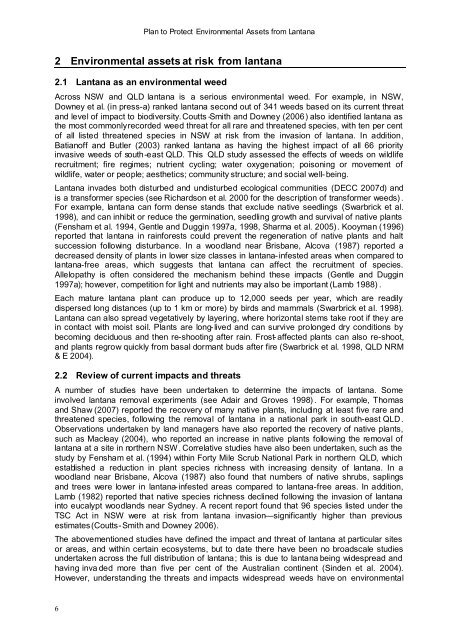Plan to Protect Environmental Assets from Lantana - Weeds Australia
Plan to Protect Environmental Assets from Lantana - Weeds Australia
Plan to Protect Environmental Assets from Lantana - Weeds Australia
Create successful ePaper yourself
Turn your PDF publications into a flip-book with our unique Google optimized e-Paper software.
<strong>Plan</strong> <strong>to</strong> <strong>Protect</strong> <strong>Environmental</strong> <strong>Assets</strong> <strong>from</strong> <strong>Lantana</strong><br />
2 <strong>Environmental</strong> assets at risk <strong>from</strong> lantana<br />
2.1 <strong>Lantana</strong> as an environmental weed<br />
Across NSW and QLD lantana is a serious environmental weed. For example, in NSW,<br />
Downey et al. (in press-a) ranked lantana second out of 341 weeds based on its current threat<br />
and level of impact <strong>to</strong> biodiversity.Coutts -Smith and Downey (2006) also identified lantana as<br />
the most commonlyrecorded weed threat for all rare and threatened species, with ten per cent<br />
of all listed threatened species in NSW at risk <strong>from</strong> the invasion of lantana. In addition,<br />
Batianoff and Butler (2003) ranked lantana as having the highest impact of all 66 priority<br />
invasive weeds of south-east QLD. This QLD study assessed the effects of weeds on wildlife<br />
recruitment; fire regimes; nutrient cycling; water oxygenation; poisoning or movement of<br />
wildlife, water or people; aesthetics; community structure; and social well-being.<br />
<strong>Lantana</strong> invades both disturbed and undisturbed ecological communities (DECC 2007d) and<br />
is a transformer species (see Richardson et al. 2000 for the description of transformer weeds).<br />
For example, lantana can form dense stands that exclude native seedlings (Swarbrick et al.<br />
1998), and can inhibit or reduce the germination, seedling growth and survival of native plants<br />
(Fensham et al. 1994, Gentle and Duggin 1997a, 1998, Sharma et al. 2005). Kooyman (1996)<br />
reported that lantana in rainforests could prevent the regeneration of native plants and halt<br />
succession following disturbance. In a woodland near Brisbane, Alcova (1987) reported a<br />
decreased density of plants in lower size classes in lantana-infested areas when compared <strong>to</strong><br />
lantana-free areas, which suggests that lantana can affect the recruitment of species.<br />
Allelopathy is often considered the mechanism behind these impacts (Gentle and Duggin<br />
1997a); however, competition for light and nutrients may also be important (Lamb 1988) .<br />
Each mature lantana plant can produce up <strong>to</strong> 12,000 seeds per year, which are readily<br />
dispersed long distances (up <strong>to</strong> 1 km or more) by birds and mammals (Swarbrick et al. 1998).<br />
<strong>Lantana</strong> can also spread vegetatively by layering, where horizontal stems take root if they are<br />
in contact with moist soil. <strong>Plan</strong>ts are long-lived and can survive prolonged dry conditions by<br />
becoming deciduous and then re-shooting after rain. Frost-affected plants can also re-shoot,<br />
and plants regrow quickly <strong>from</strong> basal dormant buds after fire (Swarbrick et al. 1998, QLD NRM<br />
& E 2004).<br />
2.2 Review of current impacts and threats<br />
A number of studies have been undertaken <strong>to</strong> determine the impacts of lantana. Some<br />
involved lantana removal experiments (see Adair and Groves 1998) . For example, Thomas<br />
and Shaw (2007) reported the recovery of many native plants, including at least five rare and<br />
threatened species, following the removal of lantana in a national park in south-east QLD.<br />
Observations undertaken by land managers have also reported the recovery of native plants,<br />
such as Macleay (2004), who reported an increase in native plants following the removal of<br />
lantana at a site in northern NSW. Correlative studies have also been undertaken, such as the<br />
study by Fensham et al. (1994) within Forty Mile Scrub National Park in northern QLD, which<br />
established a reduction in plant species richness with increasing density of lantana. In a<br />
woodland near Brisbane, Alcova (1987) also found that numbers of native shrubs, saplings<br />
and trees were lower in lantana-infested areas compared <strong>to</strong> lantana-free areas. In addition,<br />
Lamb (1982) reported that native species richness declined following the invasion of lantana<br />
in<strong>to</strong> eucalypt woodlands near Sydney. A recent report found that 96 species listed under the<br />
TSC Act in NSW were at risk <strong>from</strong> lantana invasion—significantly higher than previous<br />
estimates(Coutts-Smith and Downey 2006).<br />
The abovementioned studies have defined the impact and threat of lantana at particular sites<br />
or areas, and within certain ecosystems, but <strong>to</strong> date there have been no broadscale studies<br />
undertaken across the full distribution of lantana; this is due <strong>to</strong> lantana being widespread and<br />
having inva ded more than five per cent of the <strong>Australia</strong>n continent (Sinden et al. 2004).<br />
However, understanding the threats and impacts widespread weeds have on environmental<br />
6

















